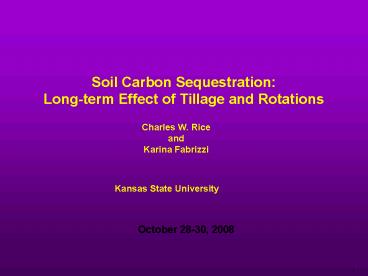Soil Carbon Sequestration: PowerPoint PPT Presentation
1 / 27
Title: Soil Carbon Sequestration:
1
Soil Carbon Sequestration Long-term Effect of
Tillage and Rotations
Charles W. Rice and Karina Fabrizzi
Kansas State University
October 28-30, 2008
2
Global economic mitigation potential for
different sectors at different carbon prices
IPCC, 2007
3
Agriculture
- A large proportion of the mitigation potential of
agriculture (excluding bioenergy) arises from
soil C sequestration, which has strong synergies
with sustainable agriculture and generally
reduces vulnerability to climate change. - Agricultural practices collectively can make a
significant contribution at low cost - By increasing soil carbon sinks,
- By reducing GHG emissions,
- By contributing biomass feedstocks for energy use
IPCC Fourth Assessment Report, Working Group III,
2007
4
Agriculture
- Rice paddies
- Irrigation
- Chemical and organic fertilizer
- Plant residue management
- Cropland
- Reduced tillage
- Rotations
- Cover crops
- Fertility management
- Erosion control
- Irrigation management
Rice fields in The Philippines
- Agroforestry
- Improved managementof trees and cropland
No-till seeding in USA
5
Agricultural Management Strategies for C
Sequestration
Develop Agricultural Management Programs that
6
Climate
Soils
Management
CO2
Sunlight
Harvestable Yield
Soil Microbial Activity Soil Organic Matter (C)
7
Potential C sequestration in U.S
Lal et al., 1999, Post et al.,2004
8
Corn production in NE Kansas
- Continuous corn
- 168 kg N/ha
- Tillage Systems
- No-tillage
- Conservation tillage (Chisel-disk)
- 15 year analysis
9
Soil C stocks after 18 years
Nicoloso et al., 2008
10
Tillage effects on soil organic C by depth,
Minnesota 14 y continuous cornMg C/ha/cm
Huggins et al., 2007
11
)
1
-
E
SOC levels (Mg C ha
O
A
Change in management
Years of cultivation
12
Soil C sequestration rates for 15 years(Mg
C/ha/y)
- NT gt Tilled, but tilled had some increase
- Added C (manure) is less conserved in tilled
- What is baseline?
Nicoloso et al., 2008
13
)
1
-
E
SOC levels (Mg C ha
D
O
C
A
Change in management
Years of cultivation
14
Net effect of NT for 15 yearsNT (0-15y) T
(0-15y)
Nicoloso et al., 2008
15
Carbon sequestration rate (C rate) expressed in
equivalent mass (Mg C/ha/y) to a 30 cm depth
except for Hayes (15 cm)
Fabrizzi, 2006
16
11 Line
Intergovernmental Panel on Climate Change (IPCC)
1.1 for CT to NT West and Post (2002) 1.16 for
CT to NT
Fabrizzi, 2006
17
Carbon sequestration rate (C rate) expressed in
equivalent mass (Mg C/ha/y) to a 15 cm depth as a
function of N rate (kg N/ha/y) located Hayes,
Kansas, USA
Fabrizzi, 2006
18
Carbon sequestration rate (C rate) expressed in
equivalent mass (Mg C/ha/y) to a 30 cm depth for
Manhattan, KS USA
Fabrizzi, 2006
19
Conservation of Soil Carbon
H2O
Organic C
Temperature
Microbial composition and activity
O2
Management
Substrate quality
Plant characteristics
Clay
Hierarchy of importance
Biological factors
Physical Protection
Disturbance
Organics
Chemical
Mineralogy
Clay
CO2
20
- Fungal Role (182w6 biomarker)
- Significant tillage X residue interaction (plt0.05)
Frey et al. (1999) found greater fungal networks
optically in NT as compared to CT for the same
soil.
White and Rice, 2007
21
White and Rice, 2007
22
Fabrizzi, 2006
23
(No Transcript)
24
No-Tillage Cropping Systems Conservation
Agriculture
- Restores soil carbon
- Conserves moisture
- Saves fuel
- Saves labor
- Lowers machinery costs
- Reduces erosion
- Improved soil fertility
- Controls weed
- Planting on the best date
- Improves wildlife habitat
25
Summary
- Soil C sequestration
- Need to examine the system
- Less disturbance
- Organic C inputs
- No-tillage must be combined with residues
- Residue removal in no-till may be worst than
tillage with residue - Agricultural soil C sequestration
- Keeps land in production in some cases
- In many cases increases profitability for the
farmer - Provides other environmental benefits to society
- Soil and Water quality (less runoff, less
erosion) - May help adapt to climate change as well as
mitigate
26
Chuck Rice Phone 785-532-7217 Cell
785-587-7215 cwrice_at_ksu.edu
- Websites
- www.soilcarboncenter.k-state.edu/
K-State Research and Extension
27
(No Transcript)

